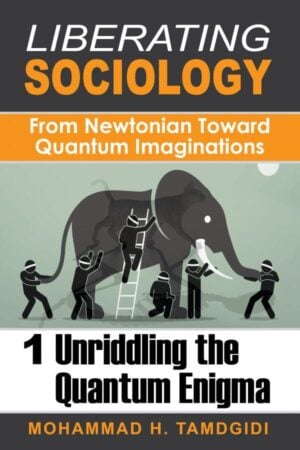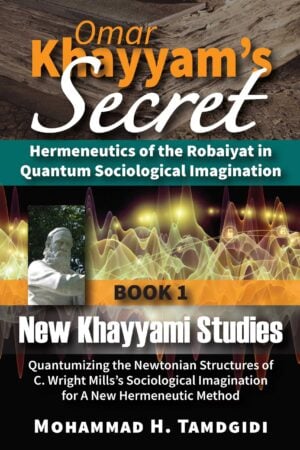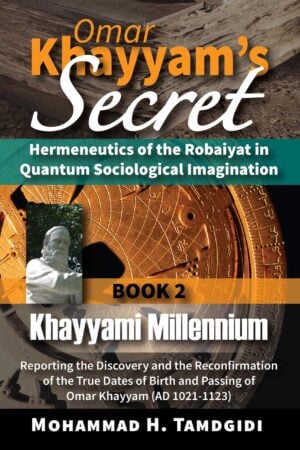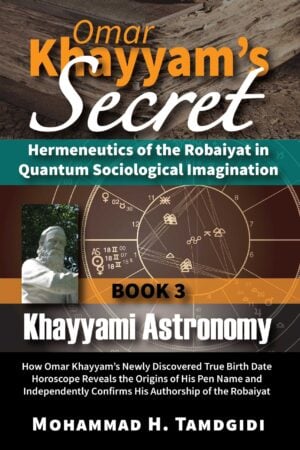Book Section: CHAPTER I—Omar Khayyam’s Literary Work “Nowrooznameh”: An Updated Persian Text and Its New English Translation for the First Time — by Mohammad H. Tamdgidi
$20.00
This essay titled “Omar Khayyam’s Literary Work “Nowrooznameh”: An Updated Persian Text and Its New English Translation for the First Time” is the first chapter of the book Khayyami Art: The Art of Poetic Secrecy for a Lasting Existence: Tracing the Robaiyat in Nowrooznameh, Isfahan’s North Dome, and Other Poems of Omar Khayyam, and Solving the Riddle of His Robaiyat Attributability, which is the seventh volume of the twelve-book series Omar Khayyam’s Secret: Hermeneutics of the Robaiyat in Quantum Sociological Imagination, authored by Mohammad H. Tamdgidi.
Description
Abstract
This essay titled “Omar Khayyam’s Literary Treatise ‘Nowrooznameh’: An Updated Persian Text and Its New English Translation for the First Time” is the first chapter of the book Khayyami Art: The Art of Poetic Secrecy for a Lasting Existence: Tracing the Robaiyat in Nowrooznameh, Isfahan’s North Dome, and Other Poems of Omar Khayyam, and Solving the Riddle of His Robaiyat Attributability, which is the seventh volume of the twelve-book series Omar Khayyam’s Secret: Hermeneutics of the Robaiyat in Quantum Sociological Imagination, authored by Mohammad H. Tamdgidi.
In this chapter Tamdgidi shares an updated all-variations-included edition of Omar Khayyam’s Nowrooznameh (The Book on Nowrooz) in Persian, and for the first time its English translation. His purpose in the chapter is not yet to offer a textual analysis of Nowrooznameh but to share its text, the analysis to be conducted in Chapter II of this volume.
The updated text of Omar Khayyam’s Nowrooznameh as shared in the chapter is based on the merging of what exists in the longer Berlin manuscript, for which the original copy of the handwritten manuscript and its editions by Mojtaba Minovi (1933) and Ali Hasouri (2006) were consulted, and the partial manuscript edited by Rahim Rezazadeh Malek (1998), where both the Berlin and the London (and a few other Turkish libraries) based manuscripts were used. Tamdgidi has included anything from Rahim Rezazadeh Malek’s edition (which includes the London variations) in curved brackets.
In the introduction of the chapter, Tamdgidi shares the background of the various extant manuscripts of Nowrooznameh and addresses, to the extent needed, the question of its attributability to Omar Khayyam and the ongoing debates about this matter in Khayyami studies. The basic points of the findings of the chapter can be summarized as follows.
The book Nowrooznameh is a coherent and well-organized book, in which its stated author, Omar Khayyam, continually reflects on the integrity of its subject matter, its purpose, and his promised and many times reminded intention of keeping it focused and short to the extent possible. It fulfills well its author’s stated goal at the beginning: “… discovering the truth about Nowrooz, which day it was for the Persian kings, why it existed, which king established it, how it was performed, why it is celebrated, and what the kings’ other ceremonies and their customs and manners were in any of their affairs.” There is simply no reason to believe that the book was somehow a joining of separately written chapters or sections written by different writers, not originally intended to comprise a single book.
The book’s sections are subtitled as follows: A. Introduction of the Book, Nowrooznameh; B. On the Customs of Persian Kings; C. The Arrival of the [Zoroastrian] Priest of Priests and the Offering of Nowroozi Gifts; D. The High Acclamation of the [Zoroastrian] Priest of Priests in Their Own Expression; E. Speaking of the Gold and What Is Necessary to Be Said About It; F. Signs of the Buried Treasures; G. Speaking of the Ring and What Is Necessary to Be Said About It; H. Speaking of the Budding Barley Grain and What Is Necessary to Be Said About It; I. Speaking of the Sword and What Is Necessary to Be Said About It; J. Speaking of the Bow and Arrow and What Is Necessary to be Said About Them; K. Speaking of the Pen and Its Attribute, and What Is Necessary to Be Said About It; L. Speaking of the Horse, Its Art, and What Is Necessary to Be Said About It; M. Names of Horses in the Persian Language; N. Speaking of the Falcon, and of Its Art, and What is Necessary About It; O. On Selecting a Falcon; P. Stories About the Benefits of the Wine; Q. Story About the Meaning of the Origin of Wine; R. A Speech on the Attribute of the Beautiful Face.
There have been only two extant manuscripts of Nowrooznameh. The Berlin manuscript C seems to be a nearly complete manuscript, in its opening clearly introducing Omar Khayyam as its author. The London manuscript B is a shorter manuscript that does not reveal its author.
Manuscript B is clearly a partial manuscript, at the very least because it lacks any information about its author. There is no way a manuscript can come into existence without one (or more) persons writing it. The fact that its author is not revealed in manuscript B leaves the possibility open that it could be a part of Omar Khayyam’s work.
Manuscript C clearly identifies its author as being Omar Khayyam. The fact that in its opening God’s blessing is wished for him, verifiably indicates that it is a copy, by a scribe other than the author himself. Therefore, as it has been the case in other treatises definitively accepted to be Khayyam’s, the expression of honorary titles for him is acceptable, since the scribe wishing God’s blessing for him obviously realizes the scientific and philosophical status of the author of the treatise being copied. So, unless irrefutable evidence is offered for an alternative author for the treatise, we must treat it as a work of Omar Khayyam.
No scholar has ever succeeded in proving that anyone other than Omar Khayyam has authored Nowrooznameh. Mohammad Mohit Tabatabai who claimed someone named Heravi was its author, later realized he had been wrong, since the only reference made to Heravi’s work (which is not extant) characterized it as a work in poetic style, not in prose. Tabatabai could not offer any other evidence proving that it was written by anyone other than Khayyam; any of his reasoning regarding the work not being worthy of Khayyam was his own speculation and based on severely limited, deficient, biased, and unaccounted for evidence and reasoning.
Mohsen Farzaneh also could not prove his speculation of Kaykhosrow Shirazi being the author of Nowrooznameh, and did not even know who the latter was, his speculation was simply guesswork based on the similarity of discussions of matters dealing with the same topic. Recent studies trying to trace his reasoning have also failed in offering any convincing argument, let alone evidence, for Farzaneh’s speculation.
A recent study of all texts written on the topic of Nowrooz since the rise of Islam up to the ninth lunar century has clearly found no evidence for anyone other than Khayyam authoring the book.
The prominent expert in old Persian manuscripts, Mohammad Qazvini, plus Mojtaba Minovi and Ali Hasouri, have confirmed that manuscript C is a work by Khayyam or based on his notes.
The Russian scholars B. A. Rozenfeld and A. P. Iushkevich studying Khayyam’s treatises also did not find any reason to doubt its authorship by Khayyam.
Scholars who have doubted Khayyam’s authorship of Nowrooznameh seem to have allowed their own understanding and interpretations of the contents of the treatise and of Khayyam’s other writings generally to shape their opinions regarding Nowrooznameh’s authorship.
Those expecting it to be a scientific treatise, for instance, have found it not meeting their expectations from a scientific treatise, as they define “scientific.” Those who have problems believing Khayyam was interested, albeit critically, in astrology, have found it unlikely that the book was written by Khayyam. Those believing that Khayyam could not have been interested in wine, or beauty, horses, falconry, this-worldly happiness, etc., have found the book less attributable to Khayyam; and so on.
Therefore, only a careful substantive study of the text of the treatise in the context of all of Khayyam’s writings can offer a scientific way of going about investigating the treatise and any lingering doubts about its authorship.
The author of a treatise cannot be fairly evaluated based on a manuscript that is not exactly the complete edition authored by him or her. Manuscript B is partial, and manuscript C, while seemingly more complete, is still a copy produced by a scribe, and is in fact lacking some passages, or could be lacking even more, since we do not have any other longer manuscript to compare it with.
There are many facts that may lead to the corruption of a manuscript, illegibility of parts of the text being only one factor to be considered. Whole words or sentence could have been, inadvertently or not (based on the scribe’s own views or biases), omitted or changed, such that only a careful analysis of the text could lead to a fair evaluation of the accuracy of the text.
Having multiple manuscripts of the same treatise, therefore, can be of significant value, since it allows for filling the gaps, or setting a passage in the relative context of the variations available.
The date a manuscript was copied can also help with the textual analysis, though no absolute rules can be set for regarding an older or newer copy to be more accurate or not.
The substance of a treatise can be best understood in the context of the author’s broader writings, and also in terms of the purpose and structure of the treatise itself. In a work of art, there can be multiple layers of meaning being woven into the narrative, so one should be particularly sensitive to the hermeneutic nature of the study of the text at hand, setting it in the historical context in which it was written, and judging its value and contribution on the basis of the meanings developed in that text itself.
We should always distinguish between the meanings arising from the study of the primary text itself and the opinions held by others about it. The differences of opinions held on the same text may itself be indicative of the complexity of meanings being woven by its author, rendering it open to different interpretations.
In a following Chapter II, Tamdgidi conducts a detailed clause-by-clause analysis of the text of Nowrooznameh.
Recommended Citation
Tamdgidi, Mohammad H. 2024. “CHAPTER I—Omar Khayyam’s Literary Work “Nowrooznameh”: An Updated Persian Text and Its New English Translation for the First Time.” Pp. 21-146 in in Omar Khayyam’s Secret: Hermeneutics of the Robaiyat in Quantum Sociological Imagination: Book 7: Khayyami Art: The Art of Poetic Secrecy for a Lasting Existence: Tracing the Robaiyat in Nowrooznameh, Isfahan’s North Dome, and Other Poems of Omar Khayyam, and Solving the Riddle of His Robaiyat Attributability. (Human Architecture: Journal of the Sociology of Self-Knowledge: Vol. XX, 2024. Tayyebeh Series in East-West Research and Translation.) Belmont, MA: Okcir Press.
Where to Purchase Complete Book: The various editions of the volume of which this Book Section is a part can be ordered from the Okcir Store and all major online bookstores worldwide (such as Amazon, Barnes&Noble, Google Play, Apple, and others).
Read the Above Publication Online
To read the above publication online, you need to be logged in as an OKCIR Library member with a valid access. In that case just click on the large PDF icon below to access the publication. Make sure you refresh your browser page after logging in.








